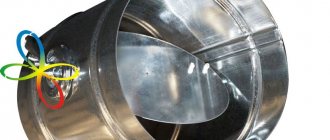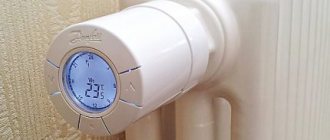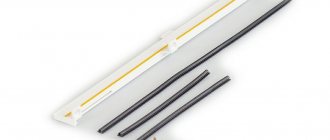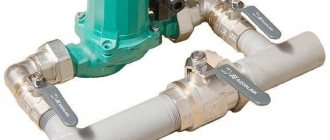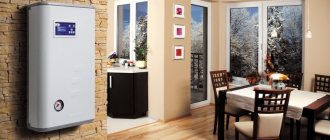Types of three-way valves
Based on their operating principle, three-way valves are divided into mixing and separating valves. The first mix two streams of water or coolant of different temperatures. The amount of incoming cold or hot liquid is adjusted to obtain the desired outlet temperature.
The separating valve changes the amount of coolant flowing from one line. It regulates the amount of fluid, increasing it in one direction and decreasing it in the other. In essence, a separation valve works like a mixing valve, but in the opposite direction.
These types of three-way valves have significant differences. In the mixing room the temperature of the coolant changes, and in the distribution room the flow rate changes.
Mixing and dividing three-way valves.
General information
Three-way valves are divided into two main types: mixing and distribution (separating) valves. The mixing tap is designed for high-quality regulation in heating systems by mixing two streams of water of different temperatures.
This is a special valve with an electric drive (12 V), servo drive or pneumatic drive, having two inputs and one output. The dividing valve is used in systems where quantitative flow control is necessary (water heating, air heating and cooling).
Three-way valve design (sectional view)
Has a ball element, one inlet and two outlets. If it is not possible to install a three-way valve, use a two-way ball valve (two or three fittings).
The difference in the operation of one three-way valve (ball or rod) and several two-way valves is that the first cannot stop the flow of coolant, while the opening of one two-way valve provokes the closure of the second (operation in reverse mode).
Servo- and pneumatic-actuated distribution valves also serve to relieve unexpected water loads.
Motorized 3-way valve overview (video)
Types of three-way valves
The most common three-way valves used in heating and water supply systems are ball and rod.
But the ball element is not included in the pneumatic actuator of industrial valves.
Therefore, it is necessary to provide a detailed classification of this product:
- a valve with a conventional thermostatic drive (expansion of the liquid medium in the drive, sensitive to temperature changes, results in pressure on the rod and regulation of different temperature flows);
- faucet with electric drive (temperature regulation is carried out according to a signal from an electric drive or a central dispatching system - a 12 V smooth control system; in fact, regulation is carried out by a ball element or rod);
- a valve equipped with a servo drive (the servo drive rotates the ball valve: by means of a temperature sensor, the valve passages with hot and cold water are opened and closed);
- a valve with a pneumatic drive (the flow of water from the passages is controlled using pressure: a spring presses on a ball element or disk, which blocks the flow of water).
Internal organization
There are two types of rotary valves - globe valves and rotary valves. They differ in their internal structure and the type of force applied for adjustment.
Latest publications:
- Which air conditioner is better, mobile or split system? Let's figure it out
- Why milk must be stored in the refrigerator and what will happen if this is not done
- Optimal temperatures in the refrigerator and freezer. How to select, configure, change. Correct arrangement of products, shelf life and temperature.
- How to store longer in the refrigerator: dill, parsley, lettuce, arugula, spinach and the rest
- 12 ways: How to cool a room or apartment in the heat without air conditioning. Survival tips.
The three-way rotary valve has a ball valve. It rotates, blocking one direction and opening another (see figure). The internal structure of such a valve is similar to a ball valve.
Operating principle of a three-way rotary valve
A seated three-way valve has a stem with one (in the mixing) or two (in the separating) shut-off devices (see figure). They are metal balls that fit tightly into a socket. When one of them blocks the flow, the second is completely open.
Types by control method
Types of control depend on operating conditions and purpose. Fixing heat main sensors transmit commands to controllers, who coordinate the actions of energy suppliers.
There are different types of drives:
- with thermostat;
- electric drive;
- pneumatic;
- hydraulic.
A manually adjusted drive is much less common.
With manual control
Manual valve
The rod is driven by a rotary handle or valve. For convenience, a control panel is installed with marks on it. Risks correspond to certain thermal hydraulic regimes.
- The positive points include:
- low cost of manual drive;
- direct control of regime indicators;
- the ability to instantly change the order of work.
The disadvantages include the need for the constant presence of an operator to respond. Manual control does not ensure uniform heating of the pipeline.
With thermostat
Valve with thermal head allows you to regulate coolant flows
A three-way heating valve is equipped with a thermostat in which liquid or gas is present. The internal environment reacts to all changes in the temperature of the flows. Heating to the specified parameters activates the thermal valve piston system and the flow of hot flow is blocked.
Three-way units with a thermostat can be mechanical or electronic. Mechanical ones operate autonomously, while electronic ones require connection to electricity or battery power. The disadvantage of the second type is compensated by absolute automation. Electronic regulation allows you to set changes in the heating order by day of the week or time of day.
Electrically driven
An electromagnet (solenoid) is installed or a combination servo drive is used, mounted on an electric motor with a transmission mechanism. The drive is coordinated by temperature or pressure meters, which are placed in the piping circuit. The unit is immediately equipped with a servo drive or supplied without it, which makes it possible to optimally select the device for actuation.
Technical characteristics of current, voltage, power, and overload capacity are taken into account. Choose one that is economical and reliable, without high operating costs, and pays attention to the surrounding operating conditions and safety requirements.
Hydraulic
The three-way heating valve with thermostat is equipped with a thermostat installed inside the housing. The device operates according to the outlet water temperature parameters, which are set at the factory. The hydraulic drive includes a housing with a plate-shaped diaphragm.
The positive aspects of use include the low price. The negative side is the need to select a hydraulic drive according to the temperature of the fluid in the heating line. The second disadvantage is the impossibility of changing the heating mode set at the factory.
Pneumatic
The pneumatic actuator automates the operation of the distribution valve and is used for remote control. The drives are a cylinder with a piston that moves under the influence of compressed air.
Advantages of using pneumatic drives:
- fast control when environmental conditions change;
- simplicity of design and interchangeability;
- the change in force is achieved by simply limiting the air pressure in the drive.
Pneumatic devices are more often used for shut-off valves. Requires additional installation of a compressed air compressor for operation.
Electrically driven
Hydraulic
Pneumatic
Peculiarities
Three-way rotary valves are characterized by high wear resistance and service life. They are designed for systems with high flow rates and pressures. In a low-load heating system, the rotary valve can be used both as a mixing valve and as a distribution valve. It all depends on the direction of installation.
Saddle-type three-way valves are less resistant to loads. They are installed in heating systems with low flow rates and pressure. They are not universal; separation and mixing differ in their internal structure.
Advantages
The key advantage of electric-powered devices is autonomy. The drive can be adjusted once, indicating the required temperature on both circuits, after which the device itself will control the operating parameters of the system, increasing or decreasing the flow of hot water into the system. In this case, the temperature sensor can have wider settings and respond to changes in the environment. For example, if it gets warmer outside, the thermostat reduces the water temperature in the “warm floor” circuit or in the heating radiators.
We recommend that you read: How to calculate and install heating registers yourself
There are other advantages:
- automatic devices allow you to avoid overheating of the coolant in the system and prevent excessive fuel consumption;
- three-way valves solve the problem of condensate removal during startup of a solid fuel boiler;
- Using the device, you can connect the circuits of the hot water supply and heating systems to one boiler.
Modern engineering systems in private homes and businesses operate on a single heat source, which heats water for both heating and hot water supply.
Note! To save on energy costs and increase the efficiency of the system, it is advisable to buy a condensing boiler that uses not only the heat of fuel combustion, but also the energy of hot condensate. Based on it, you can make a double-circuit heating system and hot water supply.
Application
Three way mixing valve
The mixing valve acts as a kind of bypass. It functions as follows:
- The coolant is supplied to the circuit (warm floors, radiators);
- As it passes through the circuit, it gives off heat and cools;
- At the outlet of the circuit, part of the coolant enters the three-way valve, where it is mixed with the heated one;
- The temperature equalizes and the coolant flows through the heating system again.
It is advisable to install three-way mixing valves in separate circuits. For example, in a heated floor system, they are installed immediately after the collector.
Choosing a three-way valve: features of models from different companies
To select a suitable valve, it is necessary to compare all the characteristics of different models, namely the type of actuator, type of drive, presence and type of thermostat, as well as the manufacturer and price of a three-way heating valve. It is worth paying attention to models from leading manufacturers.
Esbe 3-way valves: installation instructions and features
Among the main advantages of Esbe models are simplicity and affordable cost.
Three-way valve for heating manufactured by Esbe
Helpful advice! If you need to adjust the tap, avoid simple models, the main disadvantage of which is the inability to stabilize the outlet temperature.
When installing the valve, a number of features should be taken into account:
- The mixing unit allows you to create an additional circuit in the system, connected to the distribution manifold at two points, which guarantees continuous circulation of water at the outlet.
- The inlet flow is provided in case of need for additional heat.
- A valve with a thermostat is connected to the mixing unit.
- To increase the flow rate of pumping equipment, which is often insufficient due to the narrowness of the valves converging at one point, it is necessary to create an additional line that reduces the power consumption of the pump. However, such measures are not relevant for all Esbee models.
- If there is a need for a second line, it is assumed that a balancing valve is installed or a pump is connected to this additional line, which leads to equalization of the temperatures of the inlet and outlet flows.
Esbe valve integrated into the heating system
Navien three-way valves: features and advantages
The Navien company specializes in the production of heating boilers. The three-way valves of this equipment are designed to change priorities between heating water for water supply and the heating system. These valves are worth purchasing if you have Navien equipment, because components and equipment from the same manufacturer are the key to long and efficient operation of the system.
Danfoss three-way valves: features and benefits
Danfoss valves are used in heating and water supply systems. Among the advantages of this type of equipment:
- stability and accuracy of adjustment;
- ideal compatibility with other Danfoss thermostatic elements;
- reliability and long service life without loss of performance characteristics;
- ease of installation, maintenance and operation;
- fully automatic operation;
- Possibility of installation on the pipeline in any position except with the valve down.
Danfoss three-way valve
By carefully studying the technical characteristics and tips for choosing a three-way valve for heating systems, you can select the appropriate device for a specific room and operating conditions.
Tips for selection and installation
When choosing a three-way valve, it is necessary to take into account the characteristics of the heating system. otherwise problems cannot be avoided
If you need to maintain a constant temperature of the coolant, a hydraulic or thermostatic valve will be sufficient. If you plan to change the temperature regime, you should choose a valve with an electric or manual drive.
Advice
Whether you choose a manual, hydraulic or thermostatic valve, think ahead. You may want to install a servo with a controller. Therefore, choose a model with the ability to replace the drive.
When selecting, pay special attention to the following points:
- Maximum operating pressure (it must correspond to the characteristics of the heating system);
- Maximum operating temperature (must be greater than the maximum coolant temperature);
- Capacity – the internal diameter of the valve nozzles;
- Compliance of threaded connections in terms of thread pitch and diameter;
- The valve material - bronze and brass - lasts longer than steel and cast iron.
During installation, pay attention to the following points:
- It is advisable to install pressure gauges before and after the valve to monitor the pressure in the system and the load on the device;
- Install a throttling device (pressure compensator) in front of the valve in case of water hammer;
- Before installation, thoroughly clean the internal surfaces of the valve;
- The three-way valve must be positioned with the actuator at the top;
- If there is a possibility of overheating of the coolant in the system, it is necessary to additionally install a jumper (see figure);
- Install a coarse (mechanical) coolant filter in front of the valve.
Application and connection options
To prevent cold water from getting inside the solid fuel boiler during heating, you must use a connection diagram with a primary circulation circuit.
In this situation, the valve cuts off the cold coolant from the return pipe, this avoids the appearance of condensation on the inner surface of the boiler body. And this is very important, because condensation negatively affects the service life of the device. The heat source will circulate in the primary circuit until the temperature set by the user is reached. When the set value is reached, the thermostat acts on the rod, smoothly opening the flow of cold liquid from the heating system. To hydraulically adjust the mechanism, a balancing valve is installed in the small circuit. In order for the heating equipment piping circuit to work correctly, the circulation pump must be installed after the three-way valve. Many people do the opposite, which is a serious mistake.
Also in this connection option, you can use a secondary circulation circuit, which will be carried out using your own pumping equipment and a three-way valve.
Such a circuit will supply the heating system with hot liquid in the required quantity, and the pump will circulate the secondary circuit. The three-way element and pump are controlled by a controller that receives the characteristics of the heat source from special sensors.
The boiler fluid is drawn between these two circuits, where the heat source is heated to its maximum. Some manufacturers of heating boilers also equip their products with an additional circuit to provide consumers with DHW. To maintain the water temperature when supplied to the house, the units switch from the main circuit to DHW; for this purpose, special equipment is installed inside the boiler itself. The version with a direct manifold, inside of which there is a part that covers the side pipes, is slightly different. The rod in it operates using a servo drive, which receives signals from the control unit. In addition, such parts are often used in the field of underfloor heating control. In such a situation, a three-way valve with a thermal head and special temperature sensors is best suited.
According to this scheme, the heat source will be evenly distributed between different rooms of the room. This will ensure high-quality heating.
Manufacturers rating
Of course, it is impossible to definitively answer which manufacturer makes the best three-way valves. Each product has its own strengths and weaknesses. In this list, places are distributed according to price/quality ratio.
- ESBE (Sweden);
- Danfoss (Denmark);
- Watts (European Union);
- Valtec (Russia-Italy);
- Caleffi (Italy);
- Herz (Austria);
- Barberi (Italy).
In this article we tried to talk in detail about the principle of operation of a three-way valve in a heating system. also covered many other topics regarding these devices. We hope you found it useful. Don't forget to share the post with your friends!
Loading…
